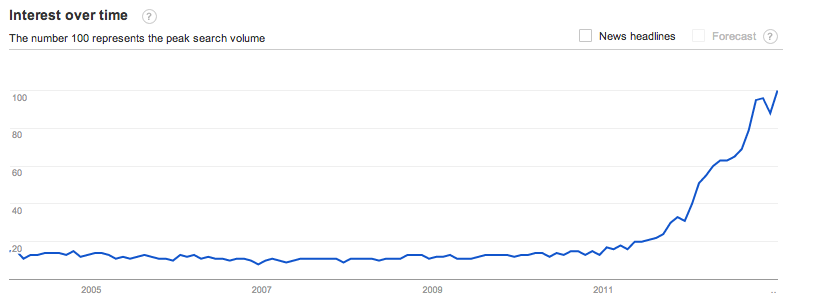 A quick glance at Google Trends data confirms that Big Data–at least as a marketing phrase–is at its peak. Over the past year the phrase has skyrocketed in popularity, most likely thanks to searchers both curious about what Big Data means, and how they should approach data management when information has more volume, variety and velocity than ever before.
A quick glance at Google Trends data confirms that Big Data–at least as a marketing phrase–is at its peak. Over the past year the phrase has skyrocketed in popularity, most likely thanks to searchers both curious about what Big Data means, and how they should approach data management when information has more volume, variety and velocity than ever before.
But analyst firm Gartner is quick to condition users that with great technology investment, comes great responsibility. Gartner found that almost three-quarters of Business Intelligence (BI) projects fail, and that only 30 percent of projects will have successfully aligned business objectives and measures by the end of next year. So how can organizations work to ensure their BI investment is as successful as possible?
I recently had the opportunity to chat with Loren Bast, Director of Business Intelligence at online humor network Cheezburger. Cheezburger invested in a new BI tool because it was unable to keep up with the amount of data it was producing across its popular humor websites such as I Can Has Cheezburger and FAIL Blog.
I asked Bast how he would have managed the project differently if he could start again. He said in an ideal world, he would have focused more on the following three things:
#1 Even with Big Data, the Small Stuff Matters — When Cheezburger introduces new data sources to its BI tools today, it ensures that the data is accurate and valid by comparing against legacy systems and closely looking at each feed before reporting is automated. But at first, this wasn’t always the case.
“We would spend a ton of time analyzing one month or three months’ worth of data, only to realize the data we were looking at wasn’t exactly what we were looking for,” says Bast.
From the beginning, organizations should invest in both people and technology to ensure that the data being analyzed is, in fact, accurate and as intended.
#2 Act as Internal Consultants When Preparing Reports — KPI-bloat was a real issue for the Cheezburger team when they started being inundated with report requests. But Bast and his department found value in not just selecting the best performance indicators, but working directly with product and engineering teams to ensure the reporting will lead to positive actions for the business.
“Now, we always ask if something valuable to the business is going to come out of the report,” says Bast. “If we can’t agree on a clear answer to that question, we just won’t build the report.”
#3 Be a Leader, Increase Buy-In — Finally, the last point Bast shared to me was a bit unexpected–when when he introduced it less than a year ago. The BI department at Cheezburger sends out daily reports on its data, but Bast had the idea to add a section at the top that focused more on the possible issues behind the data, and opened the floor for commentary from other stakeholders.
For an online business where things change daily, the new “Insanely Insightful Commentary” section is now one of the more important catalysts for action in the company today. “Opening up the conversation gets the most productive chatter going,” says Bast. But this makes sense–BI is at it best when it provides action, not just analysis. Bast simply opened the door.
For Cheezburger, improving on these three areas has allowed the organization to become what Bast calls a “service group” of the Cheezburger business–helping not only analyze its data, but direct the organization to invest more time and resources into what’s working the most.
About the Author
 Michael Koploy is an analyst and managing editor for Software Advice, a company that reports on news and trends within enterprise software. You can read more about the Cheezburger interview here: Big BI Lessons from Cheezburger’s Notorious B.I.T. For more information, he can be reached at michael@softwareadvice.com.
Michael Koploy is an analyst and managing editor for Software Advice, a company that reports on news and trends within enterprise software. You can read more about the Cheezburger interview here: Big BI Lessons from Cheezburger’s Notorious B.I.T. For more information, he can be reached at michael@softwareadvice.com.




